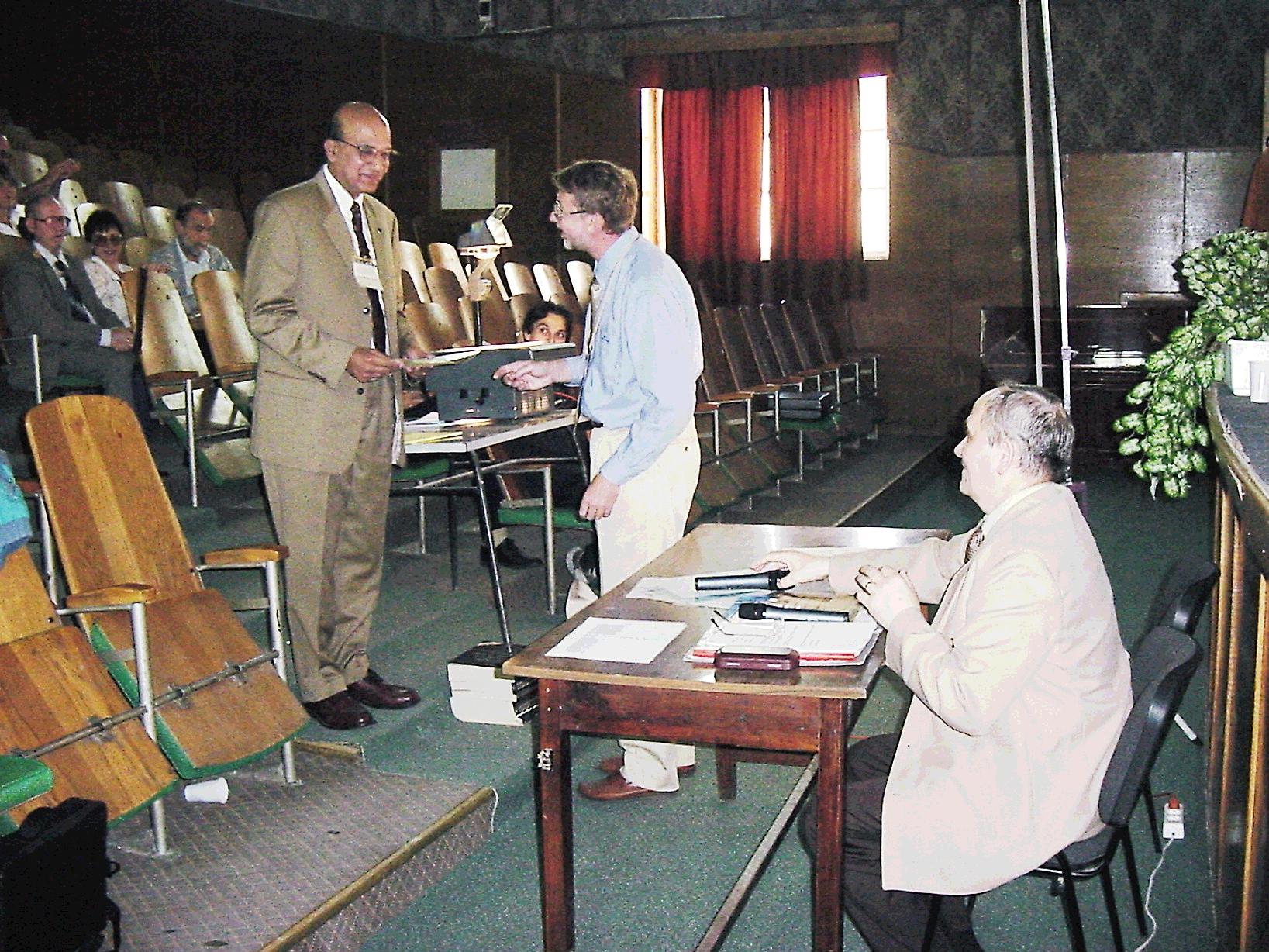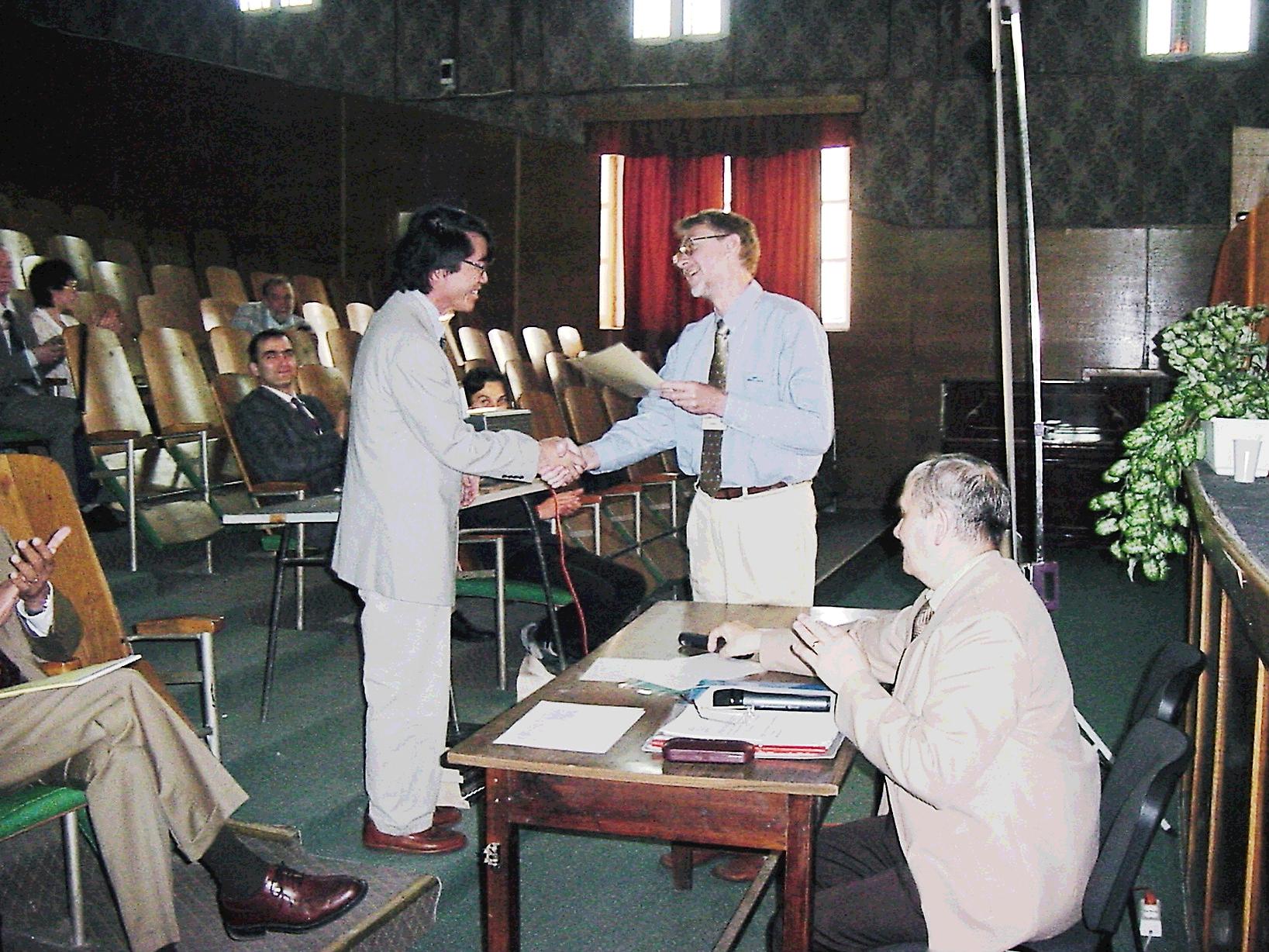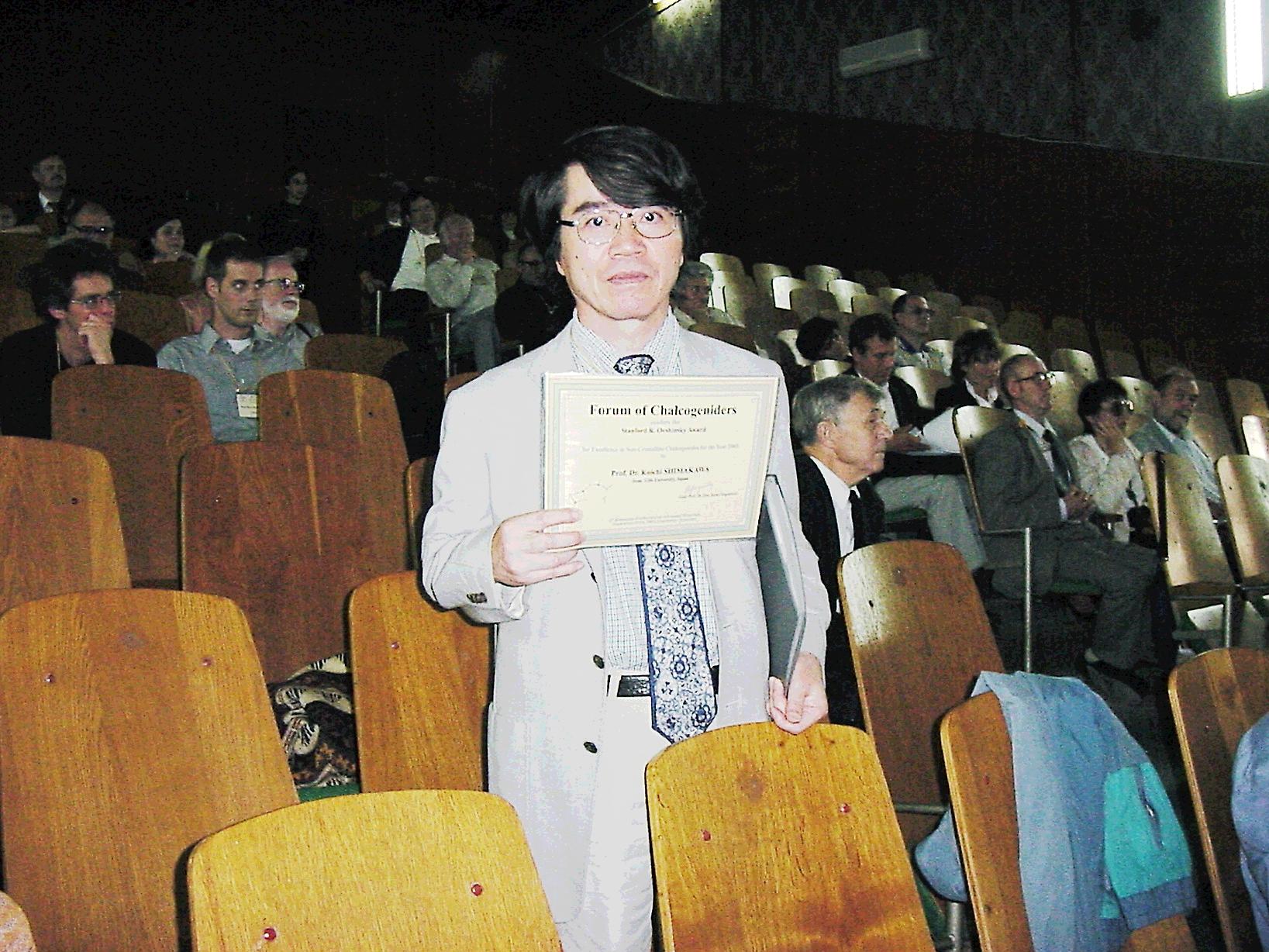"Stanford R. Ovshinsky" Award was founded in 2001, with the aim to recognize the great achievements in the field of chalcogenides. This year the award was confered during the IV-th edition of the Romanian Conference on Advanced Materials (ROCAM-2003), held in Constantza, Romania, September 15-19, 2003.
"Dear Colleagues,
More about Stanford R. Ovshinsky...
![]()
This year the winners of the award were Prof. Punit Boolchand from the University of Cincinnati, USA and Prof. Koichi Shimakawa from the Gifu University, Japan.
The speech of dr. Mihai A Popescu during the awarding ceremony:
The first Stanford R. Ovshinsky Award for Excellence in Non-Crystalline
Chalcogenides has been conferred in 2001, during the First International
Workshop on Amorphous and Nanostructured Chalcogenides, held in Bucharest,
25-28 June 2001. The winners of the Award have been, ex aequo, Prof.
Stephen R. Elliott from the University of Cambridge (UK) and Prof. Keiji
Tanaka from the Hokkaido University, Sapporo, Japan. The second Ovshinsky
Award has been confered in 2002, during the International Symposium on
Non-Oxide Glasses, ISNOG-13, held in Pardubice, Czech Republic,
September 9-12, 2002. The winners of the Award have been, ex aequo, Prof.
Victor Lyubin from Ben Gurion University of the Negev, Israel and
Dr. Alexander Kolobov, from National Institute of Advanced Industrial Science
and Technology, Tsukuba, Japan, and A.F. Joffe Physico-Technical Institute,
Sankt Petersburg, Russia.
This year the Stanford R. Ovshinsky Award for Excellence in Non-Crystalline
Chalcogenides is conferred during the Fourth Edition of the Romanian
Conference on Advanced Materials, that is held here in Constanta, Romania.
The Conference Organizers, Prof. H. Alexandru from the University of
Bucharest and Prof. V. Ciupina from University "Ovidius" Constanta kindly
accepted to organize the Awarding Ceremony here in Constanta and invited
the winners to participate to the Conference ROCAM-2003 and to give lectures.
The candidates for the Award for 2003 were proposed by outstanding
specialists in the field of chalcogenide glasses.
The following personalities accepted to be members of the Jury and
have sent proposals for candidates:
Stan Ovshinsky validated the winners of the Ovshinsky Award for Excellence in
Non-Crystalline Chalcogenides for the year 2003 (ex-aequo):

and
Prof. Koichi Shimakawa from the Gifu University, Japan.


Dr. Alexander Kolobov will present to you the winners and will hand the diploma signed by Prof. R. Grigorovici.
I congratulate the winners and I ask them to give the traditional lectures with this occasion."
Prof. Dr. Mihai Popescu
Constanta, September 17, 2003
The speech of dr. Alexander Kolobov, the chairman of the awarding ceremony:
"It was 50 years ago that Professors N.A. Goryunova and B.T. Kolomiets of the
A.F. Ioffe Physico-Technical Institute in Leningrad discovered that some
semiconductive ternary chalcogenide materials were amorphous. While nobody
seems to be surprised at this fact nowadays, the discovery was highly
unusual. Indeed, the fact that chalcogenide glasses were semiconductors meant
that they possessed valence and conduction bands separated by a forbidden gap.
It is worth reminding that the concept of the gap is quite sophisticated,
entirely dependent on quantum mechanics, and was introduced for solids in the
1930s by the pioneering work of Bloch, Peierls and Wilson. The theory was
based on an assumption that the material was crystalline, i.e. possessed
long-range order (evidenced, for example by sharp Bragg reflections). Glasses
do not exhibit sharp Bragg reflections, i.e. do not possess long-range
periodicity. How can they then possess a band structure similar to that of
homologous crystals? This discovery opened up a new field in solid state
physics and chemistry - amorphous semiconductors - a field that has been
recently very actively developing.
In the years that followed, significant
progress has been made in both understanding the physics and chemistry of the
various processes taking place in amorphous ssemiconductors and their
practical applications. While the former is more appealing for most
physicists and chemists, it is the latter that drives research. On the
application side, the major achievements were in in the development of
amorphous silicon solar cells and thin-film transistors used, for example,
in flat panel displays, and the use of chalcogenides in phase-change optical
memories. The latter application was suggested by Professor S.R. Ovshinsky in
the late 1960s which made him one of the fathers of the new field.
Two years ago, in order to commemorate the most significant contributions into both the
physics and technology of amorphous chalcogenides the prestigious
S.R. Ovshinsky Award was established. The first Awardees were Professors
S.R. Elliott from Cambridge University (UK) and Keiji Tanaka from Hokkaido
University (Japan). In 2002 two more people achieved this honour - Professor
V.M. Lyubin from the Ben-Gurion University (Israel) and Dr A.V. Kolobov from
the National Institute of Advanced Industrial Science and Technology (Japan).
It is worth noting that both awardees for the year 2002, despite working now
in different countries, originally worked in the laboratory headed by
Professor B.T. Kolomiets and this award should also be considered as a high
evaluation by the international community of the contribution of the
Leningrad school. Another year has passed and this prestigious award has
been conferred on two more scientists. Prof. P. Boolchand of the University
of Cincinnati (USA) and Prof. K. Shimakawa of Gifu University (Japan) joined
the ranks of those whose contributions have been evaluated as outstanding.
The award has become truly international and this undoubtedly manifests the
importance of the field for modern science and technology.
It is my pleasure and honour to introduce this year's winners. Professor Punit Boolchand, the
first co-winner, obtained his M.S. degree from Punjab University and PhD
from Case-Western University and has worked for most of his career at the
University of Cincinnati. He is a Fellow of the American Physical Society.
Prof. Boolchand demonstrates an enviable expertise in many different
experimental techniques. Furthermore - he has and is continuing to creatively
develop existing methods to provide new insights into experimental studies.
Very impressive examples are the facts that he introduced tin Mössbauer
spectroscopy as a tool to elucidate the structure of Ge-centered local units in glasses, applied the methods of Modulated Differential Scanning
Calorimetry for examining the fine details in the thermal behavior of glasses
and thus obtained rich information about their molecular structure,
particularly microscopic phase separation.
Very important is that he not only
collect experimental results from various methods but also coherently
analyzes them, and provides simple and direct conclusions which often yield
new insights on molecular structures and the origin of glass formation. His
recent work on self-organization effects in glasses is likely to have broad
consequences in various fields.
Another important contribution of Prof.
P. Boolchand into the field is a recently edited book "Insulating and
Semiconducting Glasses" (2000). I personally very much like the manner in
which Professor Boolchand presents his results - in a very quiet but most
persuasive voice.
Prof. Koichi Shimakawa, the second co-winner, was born in
Tokyo during WWII. This may have influenced his choice of a very peaceful
career. He graduated in Engineering from Nagoya University in 1970 and has
since continuously worked at Gifu University with a couple of European
detours (Leicester in 1981 and Glasgow in 1987). His major interest is in
comparative studies of photo-induced phenomena in chalcogenide glasses and
hydrogenated amorphous silicon.
Some of his findings are summarized in a
monograph "Advances in Amorphous Semiconductors" (2003) co-authored by Prof.
J. Singh. I have had the privilege of being his friend for over 10 years
and had the pleasure of writing several papers together. It should also be
mentioned that Professor K. Shimakawa is a very artistic person, one of his
passionate hobbies being opera.
Professors P. Boolchand and K. Shimakawa
have rightfully received this prestigious award conferred on them by the
international chalcogenide community.
Congratulations!"
Dr. Alexander Kolobov

